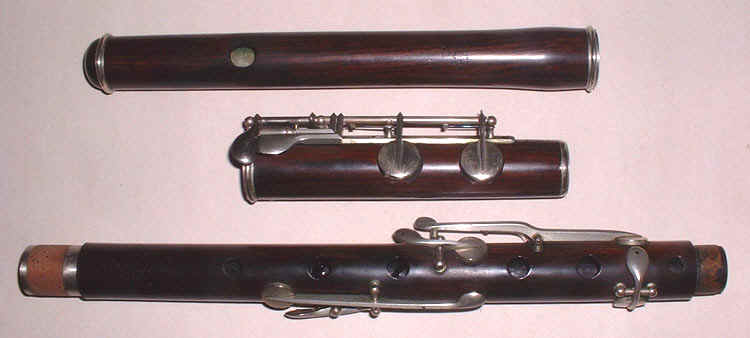I'd be confident it was intended like that. Firstly, we have seen other RC flutes with at least assymetric G#, like this one from my Unusual Rudalls page:jemtheflute wrote:Looking at that kinky G# key on the current Canadian eBay RC&Co #7232, I do rather wonder whether it was bent like that originally or if that is an adaptation - it appears to extend rather far head-wards even shortened as it is by the kink in the shank, and would do so even more if straightened and both get in the way of L3 on the A hole and be hard to operate with L4 rather tucked under L3; but then, it looks rather low on the side of the flute to me as-is.... I wonder why they didn't go for the French lateral G# - by far the best design and present on some late RC&Co flutes I've seen...

Secondly, as you point out, straightening the shaft would put the touch too far up the flute, and that is really annoying.
Thirdly, straightening the shaft would put it in the way of L3 accessing its hole. With it bent like that, it's really wrapping neatly around the end of L3 and providing a well positioned landing place for L4.
Fianlly, look at the rivet position, shown here as a little dot at the top edge of the touch. It's definitely off-centre to the touch. You can just make out the spring too following the curve of the bent shaft.

Some scoff at these late RC flutes as the cheap beginners instrument, made out-of-house using cheap metals, and they certainly don't have the visual appeal of the heyday RR flutes. But details like this I think remind us that the maker was trying his best to make a flute that worked as well as it could.
I've asked the vendor for the C#-D# length, so hopefully we can answer this question. Given the late serial number, I was expecting the flute to be aimed at modern pitch, unless it happened to be an Eb. Ah, he has just this minute got back to me with the figure 248mm, which supports modern pitch. It is interestingly the same as my 7120, which was build around 1898, just after High Pitch crashed in favour of modern pitch.Dimensions: overall length at 650mm doesn't reliably tell us all that much. Last week's #6409 (which I went to see/measure/test) has the same overall length and plays just fine at 440 with the slide open c20mm (just beyond the barrel part of the slide). It is the sounding length and C#-Eb lengths we need, + maybe the emb-C# length, to establish the probable scaling and whether or not this flute is truly an HP one (quite probable) or just, as #6409 seems to be, one with basically the old scaling, just a slightly shortened foot and head (so less flat foot and a need to pull the slide further open, but good 440 intonation....).
Terry